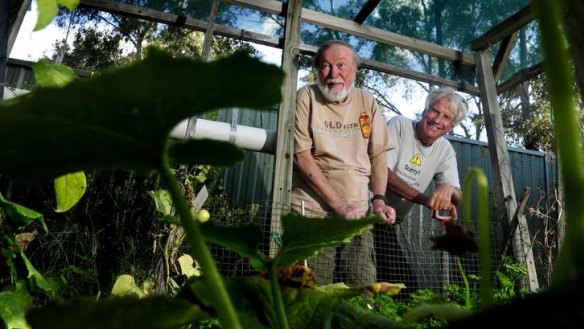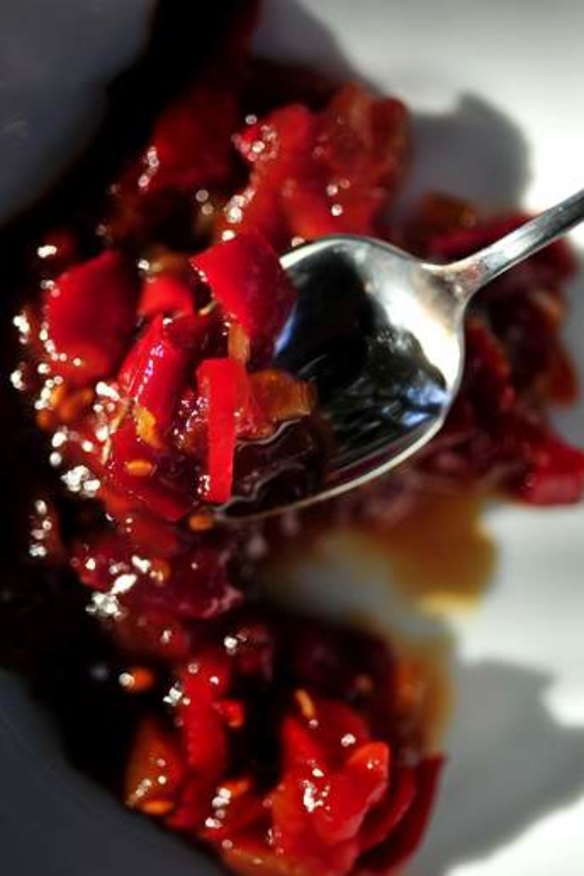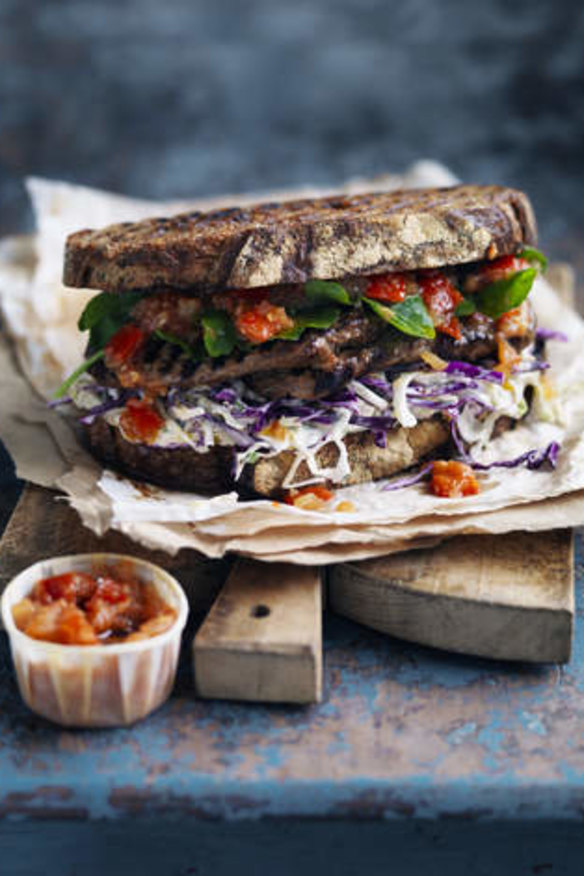Relish the hot competition
With Rockpool the judge, relish-makers left nothing to chance.

As relish-making contests go, they surely don't get more serious. The vegetarian cherry grower from Young, the plumber from Tarago, the retired diplomat from Canberra, the chestnut grower from Sassafras, and the Queenslander they refer to as Miss New South Wales for her former success in the beauty arena. These were the competitors, and they are known to each other, even related in some cases, but they turned steely rivals in the kitchen.
They co-opted the most senior of judges, chef Neil Perry, whose staff has followed the shenanigans with enthusiasm and perhaps some bafflement at the long evolution of rules and logistics.
It began when cherry grower Michael Fawcett's eye chanced on a Neil Perry recipe for tomato chilli relish with steak sandwich, published last spring in Fairfax media. It was planting season and Fawcett decided to first grow the ingredients, then make the relish. Then he decided on a challenge, inviting his brother-in-law Neil Manton to do the same. Before long, Manton's daughter and son-in-law, Lyndal and John Groom, she a public servant and he a plumber and former professional cyclist, were in on the contest.

The Brooms have a farm at Tarago, and farmer friends Alison Saunders and Richard Moxham from Sassafras chestnuts stepped up to the starting line. The involvement of Gold Coast resident Liz Ford is more hazy, but it relates to meeting Fawcett at teacher's college and bumping into him again at a 50th reunion last year. ''It was serious,'' Fawcett says. "It was a state of origin relish competition.''
So serious that Fawcett devised a complicated scoring system, awarding people extra points for produce they grew themselves. Other than cider, sugar, vinegar and spices, everything had to be home grown or bought from a farmer's market to qualify, because, as Fawcett says, ''homegrown is good, farmers' markets are good; we don't want the big supermarkets''.
Fawcett is a retired school teacher (former principal of Alexandria Park primary in Sydney) now caught up in the heartbreaking business of growing cherries at his orchard, Monteagle, near Young. ''Absolute shockers,'' he says of recent harvests, hit by drought, then two years by heavy rain at the wrong moment. ''The cherry industry in Young is stuffed.'' But he says this not with gloom, but with a characteristic gregarious cheeriness. His conversation is punctuated by a great wheezing laugh, which you might think the laugh of a big-living smoker, except that Fawcett is a vegetarian non-drinker, who eschews even caffeine and drinks chai latte. He lives the clean country life.

He resides at the end of a long dirt road, as he explained to fellow competitors, who had to post their relish to him first, before it was sent to Neil Perry in Sydney in March. This meant a trip in the mail truck driven by the postie, Terry, who in his spare time drives rally cars, Fawcett says. ''The rougher the road the better. To him, the 98-kilometre mail run he does each day over our rough, pot-holed roads is just a training run. Each day he puts the letters in the front of his truck
and the parcels in the back. Also in the back are all the other things he has been asked to deliver - like machinery parts and drums of oil.'' A hazardous trip for the relishes, which nevertheless made the journey and the onward trip to Rockpool, without obvious mishap. The jars were marked only with a letter, and accompanied by a sealed envelope disclosing how many of the ingredients were homegrown.
Fawcett grew his own tomatoes, onions, chillies, garlic, and lemons. He planted capsicum, too, but he says echidnas destroyed the soil around the capsicums by eating the worms, so he ended up having to buy capsicums at the markets. Since all entrants followed the same recipe, they believe the differences in taste came from the produce - Fawcett says it was all in the tomatoes. After much practice, grosse lisse worked best for him, ''but Miss NSW, who lives up in Queensland, she had cherry tomatoes'', he says, with maybe a hint of derision for her choice.
Richard Moxham, the joint winner with his first ever relish, used tomatoes from his Greek neighbour, and that - he believes - was the clincher. ''They're more like a fillet steak when you cut them,'' Moxham says. ''They're beauties, he handed them over to me with great care.''
Moxham remains confused about the scoring matrix, which Fawcett explains like this: ''Your scaling factor is determined by honestly stating the number of homegrown ingredients you have used and then multiplying this number by 0.1. Ingredients bought at a farmer's market should be multiplied by 0.01, as should ingredients you have nicked from neighbours (e.g. overhanging lemons). So just supposing you have grown your own tomatoes, onions, garlic and capsicum and bought chillies and ginger at a market and nicked a lemon, your scaling factor would be: 0.1+0.1+0.1+0.1+0.01+0.01+0.01 = 0.43.''
Once Rockpool awards a score out of 10, the sealed envelope containing the scaling factor is opened, and the score multiplied by the scaling factor to determine bonus points, and ultimately the winner.
''There's a lot of competition out there for a good relish,'' Moxham says dryly. As insurance in the event of a challenge, he photographed all the raw ingredients before making the relish, to a recipe he says was actually pretty challenging. ''As one very sour competitor pointed out, it's only people who don't work 9 to 5 who could do that recipe,'' he says. ''On the back of the result, the slanging is still going on.''
He used Homeleigh Grove olive oil, which he believes was also important to his success, and his own lemons, chillies and garlic. Some silly people, he points out, only made one batch. He made extra and has them stored in a location he's not revealing.
Moxham and Saunders are in the midst of harvesting from chestnuts and walnuts from a good season, but despite already being in the business of commercial food production, he says he will not add relishes to their commercial repertoire.
''If you had to scale it up, it would be hard,'' he says. ''I did a lot of plum jams this year and, at a certain point, you need a big shed and a cool store. My fridge was bulging with all this produce that I was trying to process. The beer fridge was just overflowing with produce at one stage. It got a bit frightening there towards the end.''
Neil and Dimity Manton, who live in Holt after spending his career in overseas missions as a diplomat, were equal first - their relish was preferred for flavour intensity and Moxham's for texture.
Manton says the mixed growing season kept the competitors on their toes. He planted his chillies the week after the contest began in October but they didn't ripen in time (he has bushes full of chillies now) so he bought the three bird's eye chillies from the markets. He grew his own tomatoes, capsicum, garlic and ginger, all of which he grows each year. His tip for ginger is to grow it in a big pot, otherwise it spreads. He is also the gardener at Pegasus Riding for the Disabled in Holt, so he had two chances at the produce. The capsicums were small, but okay, he says.
Manton was able to taste the relish made by his daughter and son-in-law Lyndal and John Groom, and says his had more chilli heat - too hot says his wife, but clearly to the taste of the Rockpool judges.
''The girl at Rockpool said they were very, very close,'' he says. ''And I would suppose that the difference would be whatever chillies you were able to get.''
A very colourful bunch, is the summation of Sarah Swan, from Rockpool. ''I guess they tweaked our interest very early,'' she says. ''We just kind of went, 'this could be fun'. I don't know whether this was a bad idea or a good idea in the end, but I said keep us copied in correspondence. And honestly the mail trail that ensued.''
With Perry overseas on judgment day, the relishes were judged by his head chef, Corey Costelloe, a man, Swan says, of few words who nevertheless took his task seriously, doing a parallel tasting of the relishes with and without bread. His verdict?
A (Ford): Bit too sweet. B (Manton): Very good heat, with a nice balanced spiciness. C (Groom): Not enough salt. D (Fawcett): A lot of ginger, possibly a bit too much, good texture. F (Moxham): Best texture and balance of flavour.
As for Fawcett, he's disappointed that the ACT competitors won the ''state of origin'' and is already devising an add-on for his scoring matrix to handicap territory entrants. He's also looking for a Victorian entrant for next year's contest, which looks set to be backed again by Rockpool and will probably require, he says, a grow-your-own, make-your-own pasta sauce.
Neil Perry's tomato chilli relish
Serves 4
4 medium-size ripe tomatoes
1 tbsp extra virgin olive oil
1/2 small brown onion, finely chopped
1 clove garlic, finely chopped
1/2 red capsicum, seeded and cut into 1cm dice
1 tsp finely chopped ginger
100ml cider vinegar
2 tbsp caster sugar
2 tbsp brown sugar
1 tbsp fresh lemon juice
1/2 tsp sea salt
3 red bird's-eye chillies, finely chopped
To make the relish, blanch the tomatoes in boiling water for 10 seconds, then refresh quickly in iced water. Peel, halve, remove seeds and chop into two-centimetre pieces.
Heat the oil in a large heavy-based pan. Add the onion, garlic, capsicum and ginger, stir over low heat until onion is soft and lightly browned. Add the remaining ingredients to the pan and simmer uncovered, stirring occasionally for about an hour or until the mixture thickens, being careful that the relish does not stick to the base.